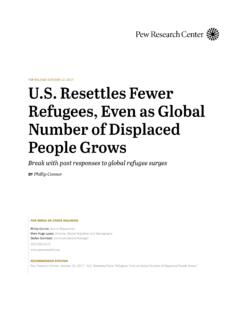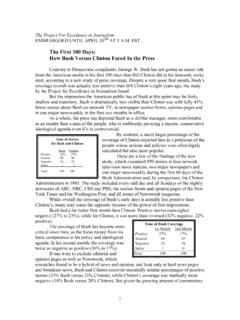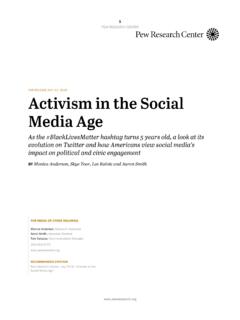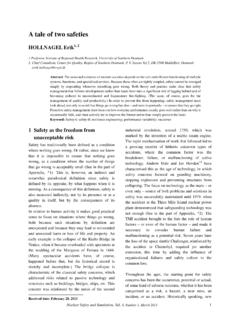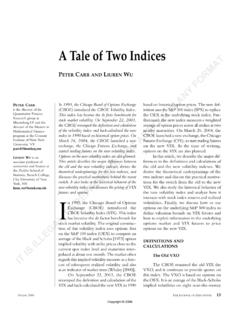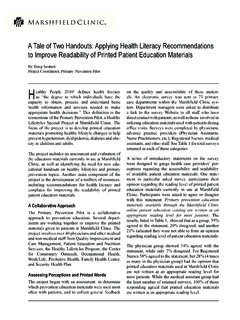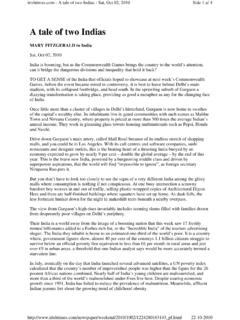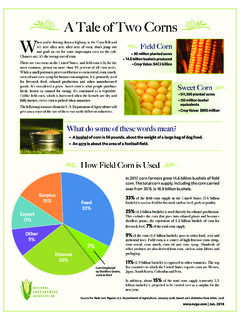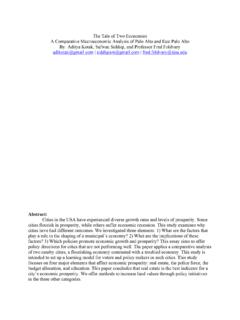Transcription of A Tale of Two Fathers - Pew Research Center
1 Social &. Demographic Trends Wednesday, June 15, 2011. A Tale of Two Fathers More Are Active, but More Are Absent Paul Taylor, Director Kim Parker, Associate Director Demographer Gretchen Livingston, Senior Researcher Wendy Wang, Research Associate Daniel Dockterman, Research Assistant FOR FURTHER INFORMATION, CONTACT. Pew Social & Demographic Trends Tel (202) 419-4375. 1615 L St., , Suite 700. Washington, 20036. 1. A Tale of Two Fathers A Tale of Two Fathers More Are Active, but More Are Absent By Gretchen Livingston and Kim Parker OVERVIEW. The role of Fathers in the modern American family is changing in important and countervailing ways. Fathers who live with their children have become more intensely involved in their lives, spending more time with them and taking part in a greater variety of activities. However, the share of Fathers who are residing with their children has fallen significantly in the past half century.
2 In 1960, only 11% of children in the lived apart from Living Apart, 1960-2010. their Fathers . By 2010, that share had risen to 27%. The % of children younger than 18. share of minor children Living apart from father living apart from their Living apart from mother 30. mothers increased only 27. modestly, from 4% in 1960 to 8% in 2010. 20. According to a new Pew Research Center analysis of 11. 10. the National Survey of 8. Family Growth (NSFG), 4. more than one-in-four 0. Fathers with children 18 or 1960 1970 1980 1990 2000 2010. younger now live apart from Source: Census Bureau, Current Population Survey and 1960 Census of their children with 11% Population living apart from some of PEW Research Center . their children and 16% living apart from all of their 2. A Tale of Two Fathers Fathers ' living arrangements are strongly correlated with race, ethnicity and socioeconomic status as measured by educational attainment.
3 Black Fathers are more than twice as likely as white Fathers to live apart from their children (44% vs. 21%), while Hispanic Fathers fall in the middle (35%). Among Fathers who never completed high school, 40% live apart from their children. This compares with only 7% of Fathers who graduated from college. Almost all Fathers who live with their children take an active role in their day-to-day lives through activities such as sharing meals, helping with homework, and playing. Fathers who live apart from their children are much less likely to be involved in these types of activities. Many compensate by communicating with their children through email or by phone: four-in- ten nonresident dads say they are in touch with their children several times a week. At the same time, however, nearly one-third of Fathers who do not live with their children say they talk or exchange email with them less than once a month.
4 Similarly, one-in-five absent Fathers say they visit their children more than once a week, but an even greater share (27%) say they have not seen their children at all in the past year. The analysis of the NSFG was paired with a new Pew Research survey of attitudes toward fatherhood that finds a strong majority of the public saying children need a father in the home. Fully 69% say having a father in the home is essential to a child's happiness. Only a slightly higher share (74%) says the same about having a mother in the home. The Pew Research survey also finds that most Fathers (63%) say being a dad is harder today than it was a generation ago. And the public gives today's dads mixed grades for the job they are doing as parents. Only about one-in-four adults say Fathers today are doing a better job as parents than their own Fathers did. Roughly one-third (34%) say they are doing a worse job, and 40% say they are doing about the same job.
5 Dads themselves have similar opinions: 26%. say today's Fathers are doing a better job than their own Fathers did. However, when asked about the job they are doing raising their own children, 47% say they're doing a better job than their own dad did; while 3% say they're doing a worse job. 1. The National Survey of Family Growth is conducted by the Centers for Disease Control and Prevention. This analysis is based on data collected from 2006 to 2008 among a nationally representative sample of 13,495 men and women ages 15-44. 3. A Tale of Two Fathers More Time Spent, But Fewer Fathers in the Home The changing role of Fathers in the home can be measured in different ways. One approach is to look at the amount of time Fathers spend caring for their Mothers, Fathers and Time Spent with Children children. Changing trends in Average weekly hours of child care among married mothers and Fathers time use data help illustrate living with their children younger than 18.
6 The extent to which Fathers who reside with their 14. children have become more 12. MOTHERS. involved in their lives over 10. time. In 1965, married 8. Fathers with children under 6. Fathers . age 18 living in their 4. household spent an average 2. of hours per week caring 0. for those children. Fathers ' 1965 1975 1985 1995 2000. time spent caring for their Note: Figures reflect the average number of hours spent in primary child care children rose gradually over activities, which includes daily care, teaching and playing. the next two decades to Source: Suzanne Bianchi, John Robinson and Melissa Milkie, Changing Rhythms of American Family Life. New York: Russell Sage Foundation, 2007 (Table ). hours per week in 1975 and 3 hours per week in 1985. PEW Research Center . From 1985 to 2000, the amount of time married Fathers spent with their children more than doubled to hours in 2000.
7 From 1965 to 2000, married mothers consistently logged more time than married Fathers caring for their minor children, though the gap between mothers and Fathers in time spent on child care narrowed significantly. Alongside this trend toward more time spent with children is a trend toward more children living apart from their Fathers . Declining marriage rates and increases in out-of-wedlock births and multi-partner fertility have given rise to complicated family structures and have increased the likelihood that Fathers will not reside with all of their According to the NSFG, nearly half of all Fathers (46%) now report that at least one of their children was born out of 2. For more information on declining marriage rates and changing family structure, see The Decline of Marriage and Rise of New Families, Pew Research Center 's Social & Demographic Trends project, November 18, 2010.
8 ( ). 4. A Tale of Two Fathers wedlock, and 31% report that all of their children were born out of wedlock. In addition, some 17% of men with biological children have fathered those children with more than one Living Apart from the Kids What is life like for Fathers who live apart from their children? As would be expected, there is a wide variety of experiences. Some Fathers are highly involved with their children, in spite of the fact that they do not live together. Others have little or no contact with their children. Roughly one-in-five Fathers who live apart from their children say they visit with them more than When Fathers and Children Live once a week, and an additional 29% see their Separately children at least once a month. For 21% of %. these Fathers , the visits take place several times a year. And for 27% there are no visits at Frequency of visits More than once a 22.
9 Week Communicating by phone or email is more 1-4 times a month 29. prevalent than face-to-face contact. Among Several times a Fathers who live apart from their minor year 21. children, 41% say they are in touch with them No visits 27. via phone or email several times a week; 28%. say they communicate at least monthly. Still, a Frequency of calls/emails sizable minority (31%) say they talk on the Several times a 41. week or more phone or email with their children less than once a month. 1-4 times a month 28. Less than once a 31. month Fathers , Children and Day-to-Day Activities Notes: Based on Fathers who are living apart from at least one child 18 or younger. Frequencies are for the prior year. Don't know/Refused responses not shown. When it comes to spending time with a child, Source: Pew Research Center calculations of the 2006-08. National Survey of Family Growth being in the same home makes a huge PEW Research Center .
10 Difference. More than nine-in-ten Fathers who live with their children at least part of the time report that they shared a meal with their child or talked with their child about the child's day almost daily over the past several weeks. Nearly two-thirds (63%) say they helped their child 3. Karen Benjamin Guzzo and Frank Furstenberg. 2007. Multipartnered Fertility among American Men, Demography 44(3): 583- 601. 4. Fathers who report that they never share a household with their children are living apart from those children. Fathers who report that they live in the same household with their children at least part of the time are living with those children. 5. A Tale of Two Fathers with homework or checked on their homework at least several times a week, and 54% say they took their child to or from activities several times a week or more. By comparison, relatively few Fathers who live apart from their children report taking part in these activities.

